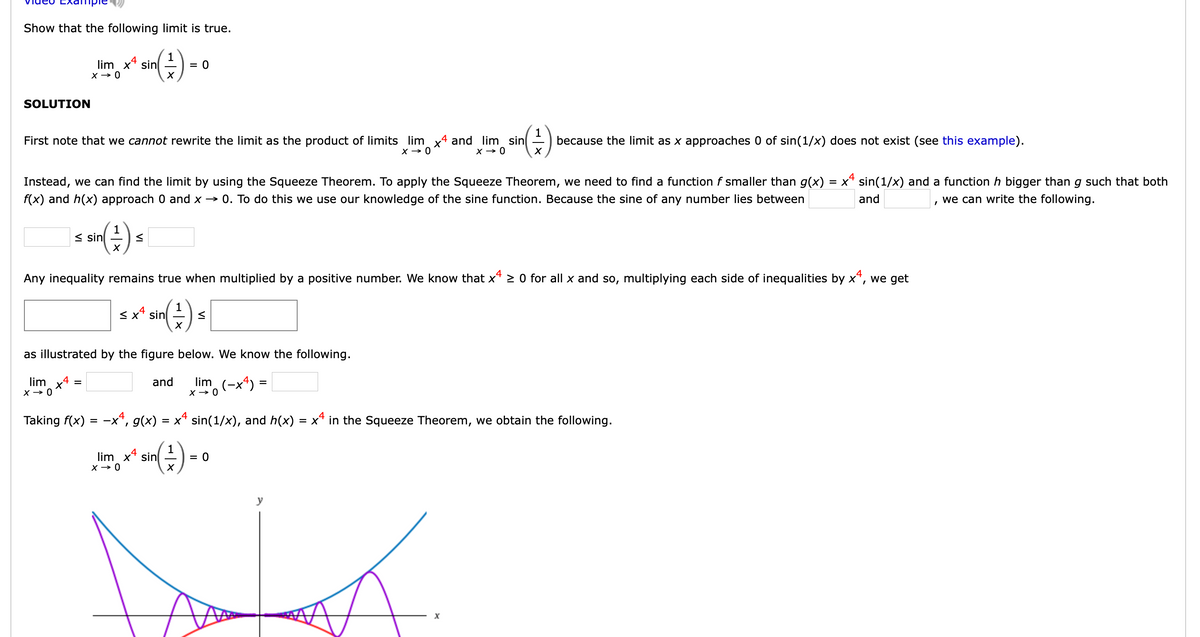Show that the following limit is true. lim x sin = 0 SOLUTION First note that we cannot rewrite the limit as the product of limits lim x4 and lim sin because the limit as x approaches 0 of sin(1/x) does not exist (see this example). x- 0 Instead, we can find the limit by using the Squeeze Theorem. To apply the Squeeze Theorem, we need to find a function f smaller than g(x) = x sin(1/x) and a function h bigger than g such that both f(x) and h(x) approach 0 and x - 0. To do this we use our knowledge of the sine function. Because the sine of any number lies between and , we can write the following. s sin Any inequality remains true when multiplied by a positive number. We know that x* 2 0 for all x and so, multiplying each side of inequalities by x*, we get sx* sin as illustrated by the figure below. We know the following. lim and lim (-x*) = Taking f(x) = -x*, g(x) = x* sin(1/x), and h(x) = x* in the Squeeze Theorem, we obtain the following. lim x sin = 0
Show that the following limit is true. lim x sin = 0 SOLUTION First note that we cannot rewrite the limit as the product of limits lim x4 and lim sin because the limit as x approaches 0 of sin(1/x) does not exist (see this example). x- 0 Instead, we can find the limit by using the Squeeze Theorem. To apply the Squeeze Theorem, we need to find a function f smaller than g(x) = x sin(1/x) and a function h bigger than g such that both f(x) and h(x) approach 0 and x - 0. To do this we use our knowledge of the sine function. Because the sine of any number lies between and , we can write the following. s sin Any inequality remains true when multiplied by a positive number. We know that x* 2 0 for all x and so, multiplying each side of inequalities by x*, we get sx* sin as illustrated by the figure below. We know the following. lim and lim (-x*) = Taking f(x) = -x*, g(x) = x* sin(1/x), and h(x) = x* in the Squeeze Theorem, we obtain the following. lim x sin = 0
Algebra & Trigonometry with Analytic Geometry
13th Edition
ISBN:9781133382119
Author:Swokowski
Publisher:Swokowski
Chapter10: Sequences, Series, And Probability
Section10.6: Permutations
Problem 47E
Related questions
Question

Transcribed Image Text:Show that the following limit is true.
()-
lim x* sin
= 0
SOLUTION
First note that we cannot rewrite the limit as the product of limits lim x4 and lim sin
X → 0
1
because the limit as x approaches 0 of sin(1/x) does not exist (see this example).
x* sin(1/x) and a function h bigger than g such that both
we can write the following.
Instead, we can find the limit by using the Squeeze Theorem. To apply the Squeeze Theorem, we need to find a function f smaller than g(x)
f(x) and h(x) approach 0 and x → 0. To do this we use our knowledge of the sine function. Because the sine of any number lies between
and
< sin
Any inequality remains true when multiplied by a positive number. We know that x* 2 0 for all x and so, multiplying each side of inequalities by x*,
we get
1
sx* sin
as illustrated by the figure below. We know the following.
.4
%3D
lim (-x*) =
lim
and
Taking f(x) = -x*, g(x) = x* sin(1/x), and h(x) = x* in the Squeeze Theorem, we obtain the following.
lim x* sin
1
= 0
y
Expert Solution
This question has been solved!
Explore an expertly crafted, step-by-step solution for a thorough understanding of key concepts.
This is a popular solution!
Trending now
This is a popular solution!
Step by step
Solved in 2 steps with 2 images

Recommended textbooks for you

Algebra & Trigonometry with Analytic Geometry
Algebra
ISBN:
9781133382119
Author:
Swokowski
Publisher:
Cengage

Functions and Change: A Modeling Approach to Coll…
Algebra
ISBN:
9781337111348
Author:
Bruce Crauder, Benny Evans, Alan Noell
Publisher:
Cengage Learning

Algebra & Trigonometry with Analytic Geometry
Algebra
ISBN:
9781133382119
Author:
Swokowski
Publisher:
Cengage

Functions and Change: A Modeling Approach to Coll…
Algebra
ISBN:
9781337111348
Author:
Bruce Crauder, Benny Evans, Alan Noell
Publisher:
Cengage Learning